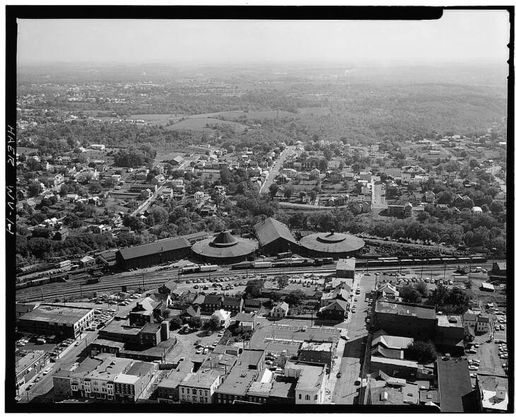Martinsburg
Roundhouse
The Great Railroad Strike of 1877
At the B&O Martinsurg Shops: Where the nation's first labor action began
The great railroad strike of 1877 started on July 16 in Martinsburg, West Virginia in response to the cutting of wages for the second time in a year by the Baltimore & Ohio Railroad. Striking workers would not allow any of the stock to roll until this second wage cut was revoked.The governor sent in state militia units to restore train service, but the soldiers refused to use force against the strikers and the governor called for federal troops.
Meanwhile, the strike spread to Baltimore causing violent street battles between the striking workers and the Maryland Militia. When the out-numbered federal troops fired on an attacking crowd, they killed 11 and wounded 40.

Pittsburgh, Pennsylvania became the site of the worst violence. Thomas Alexander Scott of the Pennsylvania Railroad, often considered one of the first robber barons, suggested that the strikers should be given "a rifle diet for a few days and see how they like that kind of bread." However, local law enforcement officers refused to fire on the strikers.
Nonetheless, his request came to pass on July 21, when militiamen bayoneted and fired on rock-throwing strikers, killing 20 people and wounding twenty-nine others. Rather than quell the uprising however, this action merely infuriated the strikers who then forced the militiamen to take refuge in a railroad roundhouse, and then set fires that razed 39 buildings and destroyed 104 locomotives and 1,245 freight and passenger cars.
On July 22, the militiamen mounted an assault on the strikers, shooting their way out of the roundhouse and killing 20 more people on their way out of the city. After over a month of constant rioting and bloodshed, President Rutherford B. Hayes sent in federal troops to end the strikes.
Three hundred miles to the east, Philadelphia strikers battled local militia and set fire to much of Center City before federal troops intervened and put down the uprising.
The strike then spread to the American Midwest and Western, increasing in brutality and intensity. On July 21, disgruntled workers in East St. Louis, Illinois, halted all freight traffic, with the city remaining in control of the workers for almost a week. The strike was finally halted by a combination of military force, and an injunction that ordered workers not to interfere with railroad operations.
On July 24, rail traffic in Chicago was paralyzed when angry mobs of groups of unemployed citizens wreaked havoc in the rail yards, shutting down both The Baltimore & Ohio and The Illinois Central Railroads. Soon, other railroads were brought to a standstill, with demonstrators shutting down the railroad traffic in Bloomington, Aurora, Peoria, Decatur, Urbana and other rail centers throughout Illinois. In sympathy, coal miners in the pits at Braidwood, LaSalle, Springfield, and Carbondale went on strike as well.

In Chicago, the Workingmen's Party organized demonstrations that drew crowds of twenty thousand people. The mayor of Chicago, Monroe Heath, asked for five thousand vigilantes to help restore order (they were partially successful), and shortly thereafter the National Guard and federal troops arrived. On July 25, violence between police and the mob erupted with events reaching a peak the following day.
These blood-soaked confrontations between police and enraged mobs occurred at the Halsted Street viaduct, at nearby 16th Street, at Halstead and 12th, and on Canal Street. The headline of the Chicago Times screamed, "TERRORS REIGN, THE STREETS OF CHICAGO GIVEN OVER TO HOWLING MOBS OF THIEVES AND CUTTHROATS." Order was finally restored, however, with the deaths of nearly 20 men and boys, the wounding of scores more, and the loss of property valued in the millions of dollars.
The Great Railroad Strike of 1877 began to lose momentum when President Hayes sent federal troops from city to city. These troops supressed strike after strike, until at last, approximately 45 days after it had started, the Great Railroad Strike of 1877 was over.






